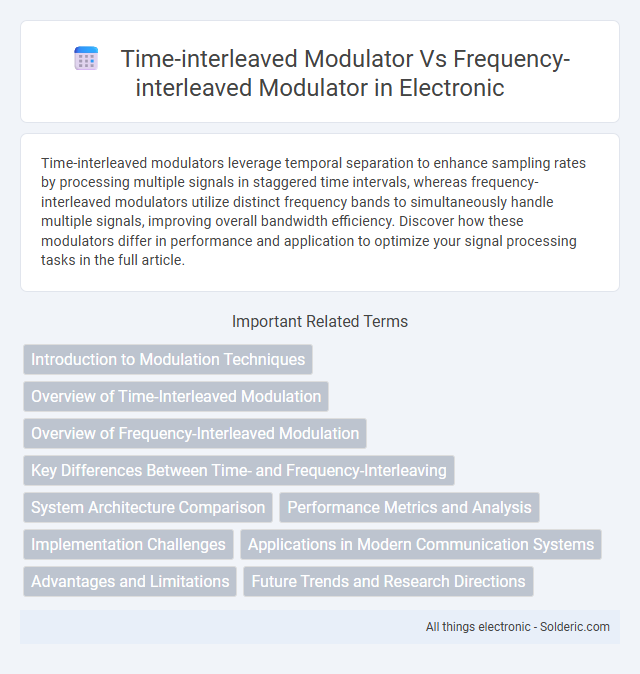Time-interleaved modulators leverage temporal separation to enhance sampling rates by processing multiple signals in staggered time intervals, whereas frequency-interleaved modulators utilize distinct frequency bands to simultaneously handle multiple signals, improving overall bandwidth efficiency. Discover how these modulators differ in performance and application to optimize your signal processing tasks in the full article.
Comparison Table
| Feature | Time-Interleaved Modulator | Frequency-Interleaved Modulator |
|---|---|---|
| Modulation Technique | Multiple modulators operate in time shifts (time domain multiplexing) | Multiple modulators operate on different frequency bands (frequency domain multiplexing) |
| Primary Application | High-speed data converters, ADCs and DACs | Multicarrier systems, broadband communication |
| Bandwidth Utilization | Same bandwidth, increased sampling rate by interleaving samples | Divides spectrum into multiple frequency bands |
| Complexity | Requires precise timing and calibration to avoid mismatches | Requires filtering and frequency planning to avoid interference |
| Advantages | Higher effective sampling rate without increasing hardware speed | Efficient spectrum usage, reduced cross-talk |
| Limitations | Timing skew, channel mismatch cause distortion | Complex filter design, spectral leakage |
| Typical Use Case | High-speed ADC/DAC with multiple interleaved channels | OFDM systems, multiband RF modulators |
Introduction to Modulation Techniques
Time-interleaved modulators divide the input signal into multiple time-shifted segments processed in parallel to increase the effective sampling rate, enhancing the resolution and speed of analog-to-digital conversion. Frequency-interleaved modulators separate the input signal into different frequency bands, enabling simultaneous conversion of distinct spectral components to improve overall bandwidth and reduce noise. Both techniques optimize modulation efficiency by addressing different challenges in high-speed, high-resolution signal processing systems.
Overview of Time-Interleaved Modulation
Time-interleaved modulation divides a high-speed data stream into multiple lower-speed parallel streams, enabling increased overall bandwidth by processing each stream in separate modulator channels. This technique reduces the complexity and power consumption per modulator while achieving high aggregate data rates critical in advanced communication systems like 5G and optical networks. Time-interleaving helps mitigate issues like timing jitter and inter-symbol interference by leveraging precise timing control and synchronization across sub-channels.
Overview of Frequency-Interleaved Modulation
Frequency-Interleaved Modulation splits the signal spectrum into multiple frequency bands, allowing simultaneous processing of different data streams within distinct frequency ranges. This technique enhances bandwidth efficiency by overlapping multiple modulated signals in the frequency domain, reducing interference and maximizing data throughput. Your communication system can benefit from increased spectral utilization and improved signal integrity through this approach compared to traditional time-interleaved modulators.
Key Differences Between Time- and Frequency-Interleaving
Time-interleaved modulators divide the signal processing across multiple parallel channels operating sequentially in time, enabling higher sampling rates and reduced latency. Frequency-interleaved modulators separately modulate distinct frequency bands simultaneously, enhancing spectral efficiency and minimizing in-band interference. The key difference lies in their division approach--time-interleaving partitions the signal in the time domain, while frequency-interleaving partitions it in the frequency domain--impacting system complexity, signal-to-noise ratio, and application suitability.
System Architecture Comparison
Time-interleaved modulators use multiple parallel modulators operating at staggered time intervals to increase overall sampling rate and improve signal processing speed, providing higher dynamic range and reduced noise. Frequency-interleaved modulators segment the signal spectrum into distinct frequency bands, each processed by individual modulators to enhance bandwidth and minimize aliasing effects. Your choice between these architectures depends on balancing performance metrics like sampling rate, complexity, and target application in signal conversion systems.
Performance Metrics and Analysis
Time-interleaved modulators enhance sampling rate and resolution by distributing input signals across multiple parallel channels, reducing noise and improving signal-to-noise ratio (SNR) and spurious-free dynamic range (SFDR). Frequency-interleaved modulators separate signals by frequency bands, effectively minimizing inter-channel interference and optimizing bandwidth allocation, which benefits applications requiring wider frequency coverage with stable linearity. Your selection depends on the desired balance between oversampling performance in time-interleaved designs and spectral efficiency offered by frequency-interleaved architectures.
Implementation Challenges
Time-interleaved modulators face implementation challenges such as precisely aligning timing across multiple channels to avoid sampling errors and maintain signal integrity. Frequency-interleaved modulators struggle with designing filters that minimize inter-band interference while ensuring adequate suppression of adjacent channel leakage. Both architectures demand rigorous calibration and compensation techniques to address mismatches and non-idealities inherent in high-speed signal processing.
Applications in Modern Communication Systems
Time-interleaved modulators enhance data throughput in high-speed digital communication systems by distributing processing workload across multiple parallel channels, making them ideal for 5G and advanced wireless networks. Frequency-interleaved modulators optimize spectrum utilization by dividing signals into distinct frequency bands, supporting multiband transmission in cognitive radio and broadband satellite communication. Both modulation techniques improve spectral efficiency and reduce interference, crucial for modern communication systems requiring high data rates and robust signal integrity.
Advantages and Limitations
Time-interleaved modulators offer the advantage of improved sampling rates and enhanced resolution by distributing the signal processing load across multiple channels, reducing aliasing effects. However, they are limited by timing mismatches and channel mismatches that can introduce distortions and require complex calibration techniques. Frequency-interleaved modulators provide better frequency domain separation and simpler implementation for distinct frequency bands but are constrained by intermodulation distortion and reduced spectral efficiency in overlapping regions.
Future Trends and Research Directions
Future trends in time-interleaved modulators emphasize enhancing timing synchronization algorithms and minimizing channel mismatch errors to improve signal fidelity in high-speed data converters. Research directions for frequency-interleaved modulators focus on optimizing filter designs and spectral efficiency to reduce intermodulation distortion and extend bandwidth capabilities. Both approaches are advancing towards integrating adaptive correction techniques and machine learning algorithms to dynamically compensate non-idealities and maximize overall system performance.
Time-interleaved modulator vs frequency-interleaved modulator Infographic

 solderic.com
solderic.com